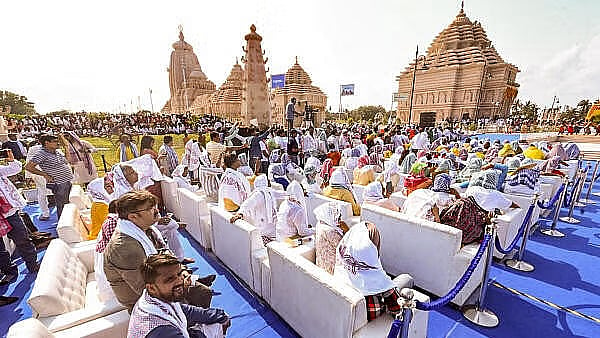
Attendees during the inauguration of the newly built Jagannath Temple in the sea resort town of Digha
Credit: PTI Photo
The inauguration of a Jagannath Temple in Digha, West Bengal, in April this year was met with a surprisingly subdued response. Public discussions remained confined to what was seen as an act of competitive religiosity between the ruling party and the state’s main opposition. However, the temple’s unveiling could mark a starting point for an interrogation — of the substantive deficits in economic management, democratic governance, and state accountability.
West Bengal’s growth story has a complex history, but certain current indicators are cause for alarm. For example, the state’s real gross state domestic product grew at an average rate of 4.3 per cent during the period from 2012-2013 to 2021-2022, compared to the national average of 5.6 per cent.
West Bengal’s share in the national gross domestic product has fallen from 6.8 per cent in 1990-1991 to 5.8 per cent in 2021-2022. Its per capita income, as of 2021-2022, was 20 per cent below the national average.
The state’s public finances reflect similar concerns. In 2022-2023, West Bengal’s fiscal deficit at 4 per cent of GSDP was lower than that of a median state, and revenue deficit at 2.6 per cent of GSDP was higher than that of a median state. The West Bengal Fiscal Responsibility and Budget Management (WBFRBM) Act has been repeatedly amended, effectively shelving the commitment to fiscal prudence.
The government’s many targeted social welfare programmes — including cash transfers to underprivileged women, subsidised rice and wheat, and health insurance — in the context of a struggling economy partially explain the ongoing fiscal imbalance. According to the 2011 Census, West Bengal is the fourth largest sender of out-migrants to other states.
A growing number of Bengalis now work as low-wage, unskilled labourers in cities like Bengaluru, Mumbai and Delhi, often in waste picking and domestic service. Though official unemployment figures in the state show a downward trend, the data masks West Bengal’s heavy dependence on other states to provide employment to its workers.
Still, the significance of the government’s large number of schemes for poor rural households cannot be ignored. During a research project on climate migration from the Sundarbans, a fisherman who works part of the year in an embroidery company in Surat told us, “Here there is always fish; the government gives us rice and a little money.” While the so-called freebies thus provide an important pillar for low-income rural households with little or no land to survive, there is no effort on the part of the state to address the oft-repeated, widely shared anguish “kaaj nei” (there is no work).
The government of the day has perhaps failed the educated lower middle class no less critically. A scam of gigantic proportions over the taking of bribes during school-teacher recruitment was followed by a recent Supreme Court ruling which declared all appointments made in 2016 through the West Bengal School Service Commission null and void due to malpractices in the recruitment process. As a result, 25,000 teachers lost their jobs. Both the teachers and the West Bengal Board of Secondary Education demanded the publication of a list separating the tainted from the untainted teachers so that the latter could be reinstated immediately. However, at a meeting in Midnapore —held shortly after the temple inauguration at Digha— the chief minister sidestepped the entire issue by asking the teachers to return to work while the government sorted out the issue of tainted versus untainted teachers.
Where did that leave the judicial ruling? Larger questions remained unaddressed: what is the level of desperation of a young aspiring teacher who must organise the resources to offer a bribe to get recruited? A constricted job market and corrupt recruitment officials leave candidates with no options but to offer a bribe. The Supreme Court’s ruling was not only to void a specific bunch of recruitments, but it was also a moral calling out of the government.
With 9,487 state high schools and 6,350 upper primary schools, the teacher strength (of 1,51, 568) is severely strained. Many schools rely on a single teacher per subject for Classes 5 to 10. There would have been a great many ways to use the Rs 250 crore, for example, to bring quality education to the state’s children by employing a large and robust community of teachers.
To be fair, one cannot place the responsibility of West Bengal’s current predicaments only at the door of the ruling TMC. The left-led coalition, which had ruled for 33 years till 2011, had seemingly done little for the state’s development. Both regimes have contributed towards hyper-politicisation of society that makes the state one of the most violence-prone during elections and even at other times. Violence and temple building in fact serve the same purpose, that of distracting attention from the largely ignored tasks of bringing development to the people. Perhaps the more important point is the lack of accountability of state power, which engages in an expensive temple construction activity while the core purpose of democratic governance, collective well-being, remains unattended to.
(The writer is a visiting professor, National Institute of Advanced Studies, Bengaluru)